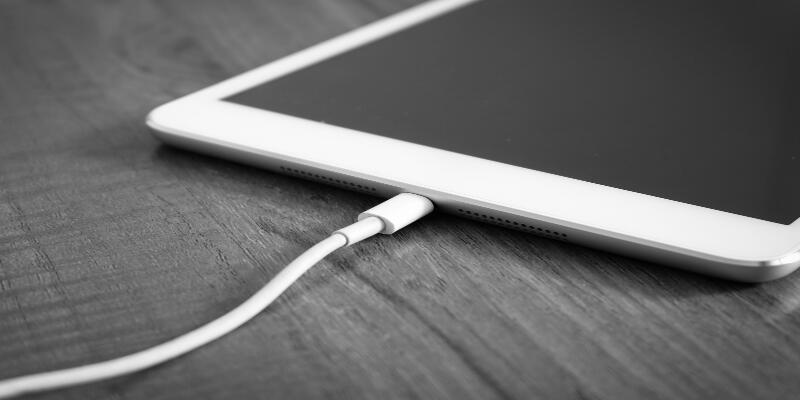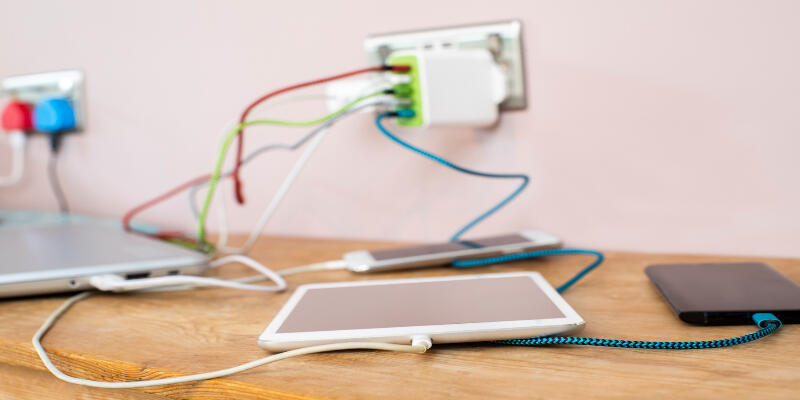Disclaimer: This post may contain affiliate links, meaning we get a small commission if you make a purchase through our links, at no cost to you. For more information, please visit our Disclaimer Page.
Tablets and smartphones have become an important part of everyday life. We have most of our lives stored on these devices and use them most days. Tablets, although larger and thus have stronger batteries under smartphones, need frequent charging in this case.
In the past, it was unhealthy for a device to charge all the time. Nowadays the devices have built-in circuit boards that protect them from overcharging, overheating, or voltage spiking so it is ok to leave a tablet plugged in all the time.

Some devices charge faster, some slower. There are countless myths about charging your devices. In this post, I will break down the myths about charging tablets, explain how to extend battery life and you will find out the answer to the eternal question – is it ok to leave a tablet plugged in all the time?
Table of Contents
Is It Ok to Leave a Tablet Plugged in All the Time?
There are various myths about charging our devices that are based on facts from the past, but also total misconceptions.
Overcharging is the term used as the main argument with such topics. If you leave the device for a long time plugged in, it will continue to use the energy causing damage to the battery. It can even lead to overheating and catching fire.
This had actually happened in the past. Namely, lithium-ion batteries would overheat if left on the charger for too long and some would even ignite and sample the reduced battery capacity.
However, there is no fear with modern tablets. They are way smarter with managing power and they gradually reduce the amount of current as the tablet charges up. It is even worse for the battery to remove the tablet from the charger before 80% charge.
Battery and charger technologies have advanced to where the battery stops charging after a while even though the charger is still plugged in. It only takes as much energy as it needs.
However, the situation with a charging port is entirely different. The cords and cables are very fragile and take care of them. It’s good not to handle your tablet while it’s charging with a cord plugged in. That will reduce the strain on the charging port and it will maintain its integrity.
Should I Turn off My Tablet When Charging?
There is no particular reason you should turn off your tablet when charging. Some people say that your tablet charges faster when it’s turned off, but that is wrong.
With the premise that background apps, phone signals, and Bluetooth are continuously draining the battery, if you turn off your tablet when charging, all the background apps and other features will turn off, and the battery-draining stops.
New tablets have high battery savings algorithms while on standby so turning your tablet off when charging won’t make any difference. I think it’s fine to leave your tablets on all the time because that’s how they’re designed to be used.
The other issue is overheating. We are aware of the fact that lithium-ion batteries aren’t fans of high temperatures and people say that their tablets are hot when charging. If they aren’t using them, it is highly unlikely that the tablets will reach a critical temperature.
If you turn off your tablet when charging you will not receive important notifications on time because the device was shut off.
The primary purpose of using mobile devices such as tablets is that you are available anywhere, anytime. It’s not convenient and user-friendly to turn off your tablet when charging.
Turning off and powering on your device causes more stress on the battery than charging it when turned on.
Can a Tablet Be Overcharged?
This is the most common rumor I have come across. With existing fast chargers there is no need to charge your tablet for a long time. The most popular thing many people do is leaving their devices to charge overnight.
In the past, batteries of mobile phones and tablets were not smart enough to detect they are fully charged, and they didn’t cut off the power supply. Modern batteries don’t have overcharging issues anymore.
Today tablets have digital circuit breakers. That means that the charging cut off when the device detects that the battery is at capacity. You can leave your tablet plugged in even though it’s fully charged and it will do no harm.
If you use your tablet when charging, it will only charge topping up to 100% and it then stops. Another thing that should be in your mind is charge cycles.
Charging from zero to full may have been good in the past, but now it’s the opposite. The major reason is different battery types. Today’s batteries are mostly lithium-ion. Lithium-ion contains a limited number of charge cycles.
Instead of letting your tablet’s battery go completely dead and then charging it full, top it off with a few small charges.
The most recommended charge for the longevity of lithium-ion batteries is plugging the device at about 40% battery capacity and charging it up to 80% at least.
Is It Bad to Use Your Tablet While Charging?
Using the table while it’s plugged in doesn’t hurt the battery but it’s not the most ideal situation. Batteries don’t like heat and its ideal temperature is around 25 degrees Celsius.
Both charging and using the tablet may cause the battery to warm up and that’s the thing you have to avoid.
When using the tablet while charging, try to avoid opening applications that use a lot of power. This will cause your charger to supply more current to your tablet and it can start the heating process.
Power consuming applications make the GPU of your tablet work harder and it will also cause your tablet to heat up.
High-temperature environment will not make your tablet’s battery explode or anything like that but it can diminish the lifespan of the battery. It’s important to point out that this will not occur if your tablet heats up a couple of times.
The damaged battery capacity will occur if the battery is exposed to heat for a longer period of time.

How Do I Make My Tablet Battery Last Longer?
Today’s tablet batteries are advanced and more sophisticated than before. You don’t have to worry that charging your tablet too long may cause a fire but there are a few tips on how to make your tablet battery last longer.
Many changes in batteries occurred out of necessity. The main feature of portable devices is mobility and the batteries had to be designed to withstand temperature fluctuations and vibrations with maximum safety and longevity.
An ideal lifespan of a lithium-ion battery is two years. Of course, that period can vary and I will reveal to you a few tips on how to maximize your battery health and lifespan.
Turn down the Brightness
The display is one of the best features of a tablet. It’s bigger than a mobile phone and it has rich colors and impressive resolution. But the display has one of the biggest energy consumption.
It uses a lot of power to light up. Turning down your brightness even a little bit can prolong your battery.
Disable Notifications
Everyone has a lot of applications on their tablets. Some apps are pre-installed on your device and there are apps that we download. Every single one of those apps sends notifications.
It’s a useful feature because you can find out information without opening the app. But in order to receive a notification, the app has to be active and refresh.
I recommend disabling the notification of apps you don’t really need.
Close Unneeded Apps
Apps are always running in the background. In the past running apps used to drain a lot of power. Nowadays, they are designed to take very little resources from your tablet.
But they still use energy so I recommend closing all apps you are not using at the moment to maximize energy saving.
Disable Unwanted Connections
There are a lot of connectivity options available on modern tablets. Bluetooth, Wi-Fi, LTE are some of them. Each one of those connectivity protocols has hardware inside your tablet. When you turn them on, you enable the corresponding hardware and provide them with power.
Many connectivity options will constantly search for ways to connect to various services. This will drain battery power and it’s one of the biggest sources of battery drain after screen brightness. Turn off every option you are not using at the moment for optimal battery consumption.
Charging Habits
Finally, one of the most important things is charging habits. If you follow the recommendations on charging habits, you can prolong the lifespan of your tablet battery significantly and maintain good battery health.
On modern tablets, try to keep them between 20% and 50% when you plug them in. Nothing will happen if the battery drops below 20% on even turns off but these are the ideal parameters.
Charge your tablet to at least 80% before unplugging it. It can even stay plugged in after its full capacity because the device stops charging when the battery is full.
While batteries are much more capable than the old ones, it’s still a good idea to take this into account to prolong your battery lifespan as long as possible.
Does Constantly Charging Laptops Reduce Battery Life?
This is one of the most controversial questions. With all said, laptops aren’t much different from tablets. It’s okay to have a laptop plugged in and charging. The most important thing to keep in mind with a laptop is the battery’s temperature.
Laptops will also stop charging when the battery is at full capacity. But you have to pay attention to your laptop heating up.
The worst thing to do is to keep a fully charged battery plugged in at an elevated temperature. That diminishes the battery’s health.
Allow your laptop to discharge somewhat before plugging it back in. That will keep electrons flowing and keep the battery from losing capacity.
Modern batteries are much safer and manageable than the old ones. Your tablets are smarter than they seem.
You can keep your tablet plugged in all the time if you want to but keep in mind these facts in order to maximize your lifespan battery and avoid unnecessary costs.
